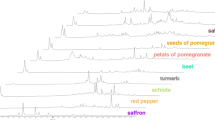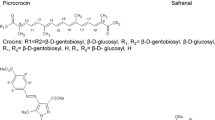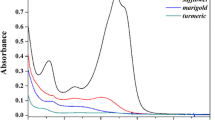Abstract
Saffron, one of the most expensive spices around the world, is highly vulnerable to economic adulteration in its powder form. Plant materials and artificial colorants are commonly used as adulterants to reduce saffron concentration as well as maintaining color strength in powdered saffron products. However, current analytical methods lack the ability to test samples accurately onsite. Therefore, the objective of this study is to develop a fast screening and quantification method combining thin-layer chromatography (TLC) and Raman spectroscopy for saffron powder analysis, including quantifying the main colorant crocin content and identifying possible adulterants out of a lab setting. A droplet of aqueous extract of saffron powder was deposited on a TLC plate, exhibiting a uniform yellow round pattern on the TLC plate. The content of crocin was analyzed using the ISO 3632 method and Raman spectroscopy separately. A quantitative model based on Raman spectra was established and validated using partial least square (PLS) with R of 0.9955 and 0.9929 for calibration and validation of the PLS plot, respectively. Possible adulterants such as powders of safflower, turmeric powder, red 40 (allura red), and yellow 5 (tartrazine) were mixed with saffron powder at various degrees. Their water extracts exhibited unique patterns under bright ambient light and UV light that can be discriminated from that of pure saffron samples through visual observation and principal component analysis (PCA) based on the L*a*b* values. We also estimated the lowest adulteration degrees that can be detected were 2.59% for Allura red, 4.15% for tartrazine, 31.01% for safflower, and 41.98% turmeric, respectively, using the PLS analysis. Further identification was evaluated using Raman spectroscopy, which provided fingerprint spectra for all adulterants except safflower. Combining TCL pattern and Raman spectroscopy, samples with identical optical properties to pure saffron but adulterated with multiple adulterants were analyzed and successfully detected. This study demonstrates the potential practical application of this method in rapid analysis of saffron quality and adulteration.

Graphical abstract






Similar content being viewed by others
References
Anastasaki EG, Kanakis CD, Pappas C, Maggi L, Zalacain A, Carmona M, Alonso GL, Polissiou MG (2010) Quantification of crocetin esters in saffron (Crocus sativus L.) using Raman spectroscopy and chemometrics. J Agric Food Chem 58(10):6011–6017
Ashrafi M, Bathaie SZ, Taghikhani M, Moosavi-Movahedi AA (2005) The effect of carotenoids obtained from saffron on histone H1 structure and H1–DNA interaction. Int J Biol Macromol 36(4):246–252
Assimiadis MK, Tarantilis PA, Polissiou MG (1998) UV-Vis, FT-Raman, and 1H NMR spectroscopies of cis-trans Carotenoids from saffron (Crocus sativus L.). Appl Spectrosc 52(4):519–522
Assimopoulou AN, Sinakos Z, Papageorgiou V (2005) Radical scavenging activity of Crocus sativus L. extract and its bioactive constituents. Phytother Res 19(11):997–1000
Bergoin M, Raynaud C, Vilarem G, Talou T (2005) Investigation on aroma volatiles from fresh flowers of saffron (Crocus sativusv L.). Spec Publ R Soc Chem 300:104
Bruni S, Guglielmi V, Pozzi F (2011) Historical organic dyes: a surface-enhanced Raman scattering (SERS) spectral database on Ag Lee–Meisel colloids aggregated by NaClO4. J Raman Spectrosc 42(6):1267–1281
Er SV, Eksi-Kocak H, Yetim H, Boyaci IH (2017) Novel spectroscopic method for determination and quantification of saffron adulteration. Food Anal Methods 10(5):1547–1555
Hamidpour R, Hamidpour S, Hamidpour M, Shahlari M (2013) Effect of Crocus sativus and its active compounds for the treatment of several diseases: a review. Int J Case Rep Images
ISO 3632-1 (2011) Saffron (Crocus sativus Linneaus). Part 1: Specifications. International Organization For Standardization
ISO 3632-2 (2010) Saffron (Crocus sativus Linneaus). Part 2: Test Methods, International Organisation for Standardization
Parker FS (1983) Applications of infrared, Raman, and resonance Raman spectroscopy in biochemistry. Springer Science & Business Media
Peter KV (2000) Saffron. Handbook of Herbs and Spices
Petrakis EA, Polissiou MG (2017) Assessing saffron (Crocus sativus L.) adulteration with plant-derived adulterants by diffuse reflectance infrared Fourier transform spectroscopy coupled with chemometrics. Talanta 162:558–566
Premkumar K, Thirunavukkarasu C, Abraham SK, Santhiya ST, Ramesh A (2006) Protective effect of saffron (Crocus sativus L.) aqueous extract against genetic damage induced by anti-tumor agents in mice. Hum Exp Toxicol 25(2):79–84
Sabatino L, Scordino M, Gargano M, Belligno A, Traulo P, Gagliano G (2011) HPLC/PDA/ESI-MS evaluation of saffron (Crocus sativus L.) adulteration. Nat Prod Commun 6(12):1934578X1100601220
Schmidt C, Trentelman K (2009) 1064 nm dispersive Raman micro-spectroscopy for the in-situ identification of organic red colorants. Preserv Sci 6:10–21
Schulz H, Baranska M, Baranski R (2005) Potential of NIR-FT-Raman spectroscopy in natural carotenoid analysis. Biopolymers 77(4):212–221
Sereshti H, Poursorkh Z, Aliakbarzadeh G, Zarre S, Ataolahi S (2018) An image analysis of TLC patterns for quality control of saffron based on soil salinity effect: a strategy for data (pre)-processing. Food Chem 239:831–839
Socrates G (2004) Infrared and Raman characteristic group frequencies: tables and charts. John Wiley & Sons
Sujata V, Ravishankar GA, Venkataraman LV (1992) Methods for the analysis of the saffron metabolites crocin, crocetins, picrocrocin and safranal for the determination of the quality of the spice using thin-layer chromatography, high-performance liquid chromatography, and gas chromatography. J Chromatogr A 624(1-2):497–502
Tarantilis PA, Beljebbar A, Manfait M, Polissiou M (1998) FT-IR, FT-Raman spectroscopic study of carotenoids from saffron (Crocus sativus L.) and some derivatives. Spectrochim Acta A Mol Biomol Spectrosc 54(4):651–657
Verma SK, Bordia A (1998) Antioxidant property of saffron in man. Indian J Med Sci 52(5):205–207
Zheng J, He L (2014) Surface-enhanced Raman spectroscopy for the chemical analysis of food. Compr Rev Food Sci Food Saf 13(3):317–328
Author information
Authors and Affiliations
Corresponding author
Ethics declarations
Conflict of Interest
Haochen Dai declares that he has no conflict of interest. Qixiang Gao declares that he has no conflict of interest. Lili He declares that she has no conflict of interest.
Ethical Approval
This research does not contain any studies with human participants or animals.
Informed Consent
Informed consent is not applicable to this study.
Additional information
Publisher’s Note
Springer Nature remains neutral with regard to jurisdictional claims in published maps and institutional affiliations.
Electronic supplementary material
ESM 1
Raman spectrum of three saffron specimens from three different suppliers. (The ISO standard ratings of each sample were expressed as ISO + mean color strength value + SD). (JPG 437 kb)
ESM 2
Difference plot between predicted and actual values of PLS regression from L*a*b* data of pure saffron extract. (JPG 352 kb)
ESM 3
Difference plot between predicted and actual values of PLS regression from Raman spectrum data. (JPG 395 kb)
ESM 4
Difference plots between predicted and actual values of PLS regression from L*a*b* data of different spiked saffron specimens (a. safflower; b. turmeric; c. Allura red; d. tartrazine). (JPG 1234 kb)
Rights and permissions
About this article
Cite this article
Dai, H., Gao, Q. & He, L. Rapid Determination of Saffron Grade and Adulteration by Thin-Layer Chromatography Coupled with Raman Spectroscopy. Food Anal. Methods 13, 2128–2137 (2020). https://doi.org/10.1007/s12161-020-01828-x
Received:
Accepted:
Published:
Issue Date:
DOI: https://doi.org/10.1007/s12161-020-01828-x




